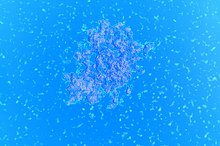Flu-Like Symptoms From a Staph Infection
Seek treatment for a staph infection, as soon as the flu-like symptoms appear. Consequences for late or neglected treatment for may cause serious medical conditions or even death. In fact, certain strains of staph may increase the fatality rate among certain populations. A 2009 study at the Henry Ford Hospital shows that some strains of the infection-causing bacteria may have a 50 percent fatality rate, particularly among hospital-acquired staph infections 5. Early recognition of the flu-like symptoms may provide patients with the advantage of early and successful treatment.
If you are experiencing serious medical symptoms, seek emergency treatment immediately.
Respiratory
Staph infections can affect all body mechanisms, including vital organs, such as the lungs 5. As a result, staph infections may cause breathing problems may occur 5. Pneumonia may develop, particularly seen among populations with compromised immune systems, such as the geriatric and pediatric populations. Severe coughing, hacking or the feeling of not getting enough air are respiratory symptoms that may develop from staph infection, the same symptoms experienced when having a bout with the flu.
- Staph infections can affect all body mechanisms, including vital organs, such as the lungs 5.
- Pneumonia may develop, particularly seen among populations with compromised immune systems, such as the geriatric and pediatric populations.
Body Pains
What Are the Symptoms of Worms in the Human Body?
Learn More
Body aches and pains are common flu-like symptoms of MRSA. A discriminating difference between bodily pains experienced with the flu and inflictions felt by a staph infection is the septic pain, or pain occurring within the joints. Joint inflammation occurs when a staph infection travels through the blood stream. Maneuvering the limb with affected joint may cause increased pain. Abscesses or skin boils are typical reactions to staph infections and can cause inflammation and agonizing pain in the affected area, especially on areas where the body folds or creases 5.
- Body aches and pains are common flu-like symptoms of MRSA.
- Abscesses or skin boils are typical reactions to staph infections and can cause inflammation and agonizing pain in the affected area, especially on areas where the body folds or creases 5.
Fever
A fever is the body’s immune response to a virus or bacteria. A climbing fever may cause chills or hot flashes, as the body adapts to a warmer body temperature. Chills and hot flashes may subside after the body temperature reaches the fever temperature—determined by the body’s immune system.
Nausea
CRV Infections
Learn More
An upset stomach is a typical flu-like symptom caused by MRSA. Examples include flank pain, vomiting and a loss of appetite. Often, nausea is the first flu-like symptom caused by a staph infection, and the last symptoms relieved once the infection clears up.
- An upset stomach is a typical flu-like symptom caused by MRSA.
- Often, nausea is the first flu-like symptom caused by a staph infection, and the last symptoms relieved once the infection clears up.
Diarrhea
Diarrhea, with or without abdominal cramping, may be a flu-like symptom caused by a bacterial infection, particularly infections caused by spoiled or unclean food. According to the Mayo Clinic, staph-related food poisoning may cause diarrhea within 1 to 6 hours after eating the contaminated food 5. Diarrhea caused by the flu virus often lasts longer than the short-lived symptoms caused from a staph infection.
Related Articles
References
- Natural News: Deadly MRSA Superbug Has 50 Percent Mortality Rate in Hospital Patients
- Science Daily: Senior Citizens At Risk For Pneumonia
- Rheumatology: Community-Acquired Septic Arthritis Due To Methicillin-Resistant Staphylococcus Aureus
- “The Johns Hopkins Complete Home Guide to Symptoms & Remedies”; Simeon Margolis M.D. Ph.D.; 2004
- Mayo Clinic: Staph Infections
- Harris A (Updated January 2019). Patient education: Methicillin-resistant Staphylococcus aureus (MRSA) (Beyond the Basics). Lowy FD, ed. UpToDate. Waltham, MA: UpToDate.
- King JM, Kulhankova K, Stach CS, Vu BG, Salgado-pabón W. Phenotypes and Virulence among Staphylococcus aureus. USA100, USA200, USA300, USA400, and USA600 Clonal Lineages. mSphere. 2016;1(3). doi:10.1128/CMR.00134-14
- Cleveland Clinic. (September 2019). Staph Infection (Staphylococcus Infection)
- Tong SY, Davis JS, Eichenberger E, Holland TL, Fowler VG Jr. Staphylococcus aureus infections: epidemiology, pathophysiology, clinical manifestations, and management. Clin Microbiol Rev. 2015 Jul;28(3):603-61. doi:10.1128/CMR.00134-14
- Sukumaran V, Senanayake S. Bacterial skin and soft tissue infections. Aust Prescr. 2016;39(5):159-163. doi:10.18773/austprescr.2016.058
- Bush L. (Modified June 2019). Merck Manual Consumer Version. Staphylococcus aureus Infections. (Staph Infections)
- De oliveira TH, Amorin AT, Rezende IS, et al. Sepsis induced by Staphylococcus aureus: participation of biomarkers in a murine model. Med Sci Monit. 2015;21:345-55. doi:10.12659/MSM.892528
- Harris A (Updated January 2019). Patient education: Methicillin-resistant Staphylococcus aureus (MRSA) (Beyond the Basics). Lowy FD, ed. Waltham, MA:
- Centers for Disease Control and Prevention. Invasive Methicillin-Resistant Staphylococcus aureus Infections Among Persons Who Inject Drugs. Six Sites, 2005–2016.
- Hassanzadeh P, Hassanzadeh Y, Mardaneh J, Rezai E, Motamedifar M. Isolation of Methicillin-Resistant Staphylococcus aureus (MRSA) from HIV Patients Referring to HIV Referral Center, Shiraz, Iran, 2011-2012. Iran J Med Sci. 2015;40(6):526-30.
- Chu C, Wong MY, Tseng YH, et al. Vascular access infection by Staphylococcus aureus from removed dialysis accesses. Microbiologyopen. 2019;8(8):e00800. doi:10.1002/mbo3.800
- Tong SY, Davis JS, Eichenberger E, Holland TL, Fowler VG Jr. Staphylococcus aureus infections: epidemiology, pathophysiology, clinical manifestations, and management. Clin Microbiol Rev. 2015 Jul;28(3):603-61. doi:10.1128/CMR.00134-14
- Romero-gómez MP, Cendejas-bueno E, García rodriguez J, Mingorance J. Impact of rapid diagnosis of Staphylococcus aureus bacteremia from positive blood cultures on patient management. Eur J Clin Microbiol Infect Dis. 2017;36(12):2469-2473. doi:10.1007/s10096-017-3086-5
- Missiakas DM, Schneewind O. Growth and laboratory maintenance of Staphylococcus aureus. Curr Protoc Microbiol. 2013;Chapter 9:Unit 9C.1. doi: 10.1002/9780471729259.mc09c01s28
- Kobayashi SD, Malachowa N, Deleo FR. Pathogenesis of Staphylococcus aureus abscesses. Am J Pathol. 2015;185(6):1518-27. doi:10.1016/j.ajpath.2014.11.030
- Centers for Disease Control and Prevention. (2019). Deadly Staph Infections Still Threaten the U.S.
- Centers for Disease Control and Prevention. (2011). Staphylococcus aureus in Healthcare Settings.
Resources
Writer Bio
Cheryl Myers has has a master's degree from Saint Leo University and currently writes for several publications including Fit Pregnancy, Guideposts and Parent's Magazine.








